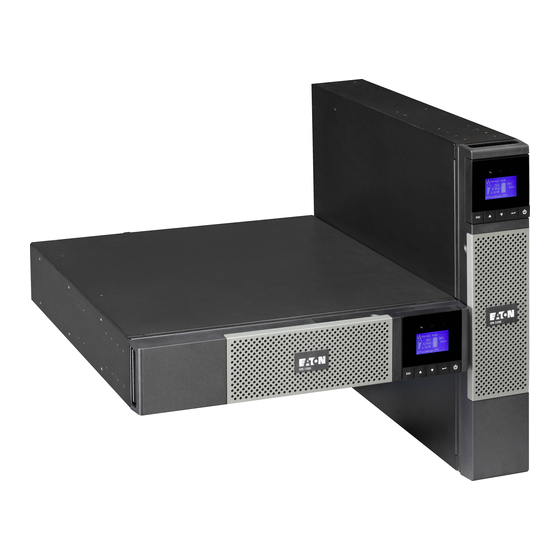
Table of Contents
Advertisement
Advertisement
Table of Contents

Summarization of Contents
IMPORTANT SAFETY INSTRUCTIONS
Certification Standards
Lists standards like UL, IEC, FCC, IEEE for UPS performance and safety.
Special Symbols
Explains common symbols used on UPS for warnings and information.
Safety of Persons
Handling Precautions
Safety measures during handling, including electrical shock and battery precautions.
Product Safety
Special Precautions
Specific warnings for installation, storage, and battery module replacement.
1. Introduction
1.1 Environmental protection
EATON's environmental policy, eco-design, and substance content.
2. Presentation
2.1 Standard installations
Describes tower and rack installation configurations for UPS models.
2.2 Rear panels
Details the connectors and ports on the rear of various UPS models (5PX 1000/1500, 2200, 3000, EBM).
2.3 Control panel
Explains the five-button graphical LCD, indicators, and buttons on the UPS control panel.
2.4 LCD description
Describes the UPS screen saver and status information displayed on the LCD.
2.5 Display functions
Details how to navigate menus and view information using the UPS control panel.
2.6 User settings
Local settings
Configuration options for language, LCD brightness, and audible alarms.
In/Out settings
Settings for input thresholds, sensitivity, and load segment delays.
ON/OFF settings
Settings for auto-restart, energy saving, sleep mode, and remote commands.
Battery settings
Configuration for automatic battery tests, low battery warnings, and deep discharge protection.
3. Installation
3.1 Unpacking and contents check
Lists the UPS components and accessories included in the package.
3.2 Battery module connection
Instructions on how to connect the internal battery module to the UPS unit.
3.3 Tower installation
Steps for setting up the UPS in a vertical tower configuration.
3.4 Rack installation
Instructions for mounting the UPS into a standard 19-inch equipment rack.
3.5 Communication ports
Explains how to connect RS232, USB, and optional communication cards for UPS management.
3.6 Connection with a FlexPDU (Power Distribution Unit) module (optional)
Guide for connecting the UPS to a FlexPDU for distributed power outlets.
3.7 Connection with a HotSwap MBP module (optional)
Instructions for connecting the UPS to a HotSwap MBP for maintenance without load interruption.
HotSwap MBP module operation
Details the operation of the HotSwap MBP module, including switch settings and indicator lights.
3.8 UPS connection without a FlexPDU or HotSwap MBP module
Steps for connecting the UPS directly to the AC power source and loads.
4. Operation
4.1 Start-up and Normal operation
Procedures for starting the UPS and confirming normal operation.
4.2 Starting the UPS on Battery
How to start the UPS using only battery power (cold start).
4.3 UPS Shutdown
Steps for safely shutting down the UPS unit.
4.4 Operation on Battery Power
Explains how the UPS operates when AC power is lost and battery power is used.
Low-battery warning
Alerts for low battery status and recommended actions to prevent data loss.
End of battery backup time
Indicates what happens when the UPS battery is fully depleted.
4.5 Return of AC Input Power
Describes how the UPS automatically restarts when AC power is restored.
4.6 UPS remote control functions
Explains how to use remote control functions like RPO and ROO.
5. Maintenance
5.1 Troubleshooting
Guide to diagnose and resolve common UPS operating issues and fault conditions.
Troubleshooting a UPS equipped with the HotSwap MBP module
Specific troubleshooting steps for issues related to the HotSwap MBP module.
6. Appendices
6.1 Technical specifications
Provides detailed technical data, ratings, and specifications for the UPS models.
6.2 Glossary
Defines key terms and acronyms used throughout the UPS manual.












Need help?
Do you have a question about the 5PX 3000 RT3U and is the answer not in the manual?
Questions and answers